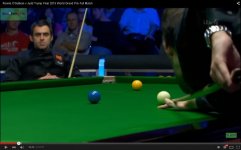He may mean near max velocity while accelerating
Maybe like what would be if a ball were not in the way.
Just kidding.
Acceleration is the change in velocity. So the greatest acceleration could be when the cue goes from zero at the 'pause' or change of direction to the midway point & may not actually be at contact although it could still be accelerating but just doing so at a slower rate of acceleration.
Or... with a certain wrist or finger action the cue could have it's highest rate of acceleration right before contact.
There is a term used in golf. It's tempo. There are players like Fred Couples that very slowly & gradually builds speed, sort of like a constant rate of acceleration. Then there are others that while not really much faster or even slower at impact make a much quicker swing. There rate of acceleration is most probably higher than Couples' but at at slower velocity at impact.
Just as there are many different golf swings, there are many pool strokes.
The thing is that the golf swings have been extensively studied. Any amateur golfer can walk into a Edwin Watts Golf Shop & have certain aspects of there golf swing analysed by computers.
Pool/Billiards is 'light years' behind golf... & tennis...& baseball, etc.
Best 2 You & All,
Rick
Last edited:
